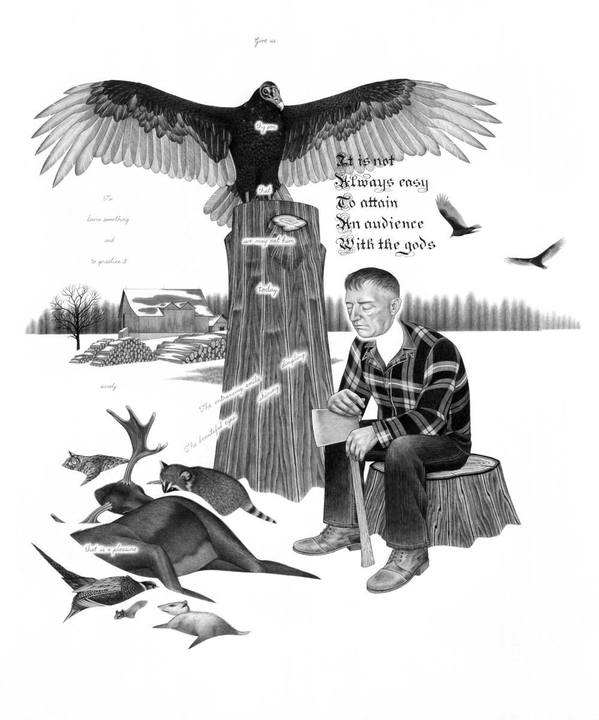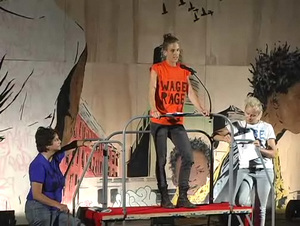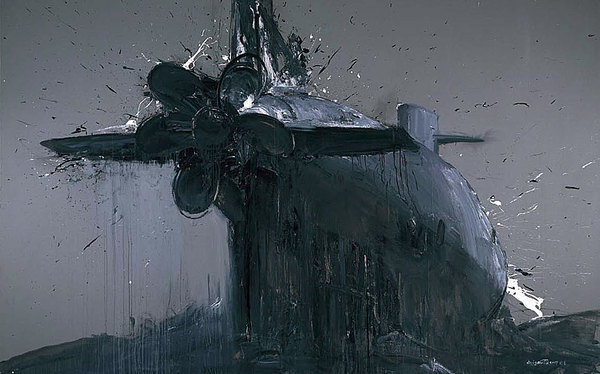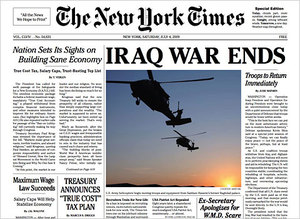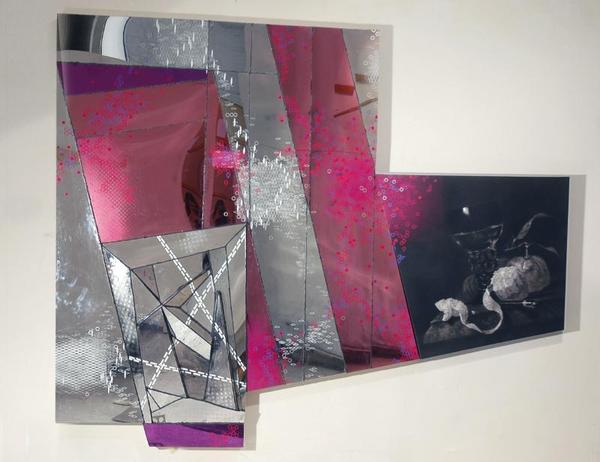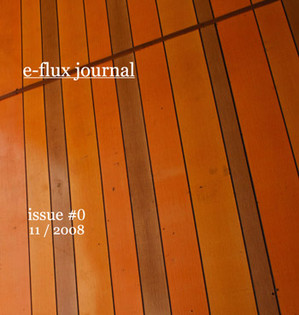This is an archive of the ArtCat Zine, 2007-2009. Please visit our new project, IDIOM.
November 2008
A Maze
Celso, Infinity, Stikman, LAII & Cbeauty
Factory Fresh - 1053 Flushing Avenue, Brooklyn NY
14 November - 2 December 2008
One of the biggest obstacles for street artists trying to make a living is the transition from street to the gallery context. It may be considered inauthentic to restrain your creativity to the confines of a commercial gallery system, but an artist (street or otherwise) has to make a living. Sometimes it works, like Judith Supine's flawless transition with his Dirt Mansion show at English Kills earlier this year. Other times is doesn't; think London street art gallery Lazarides' New York exhibit in October at the corner of Bowery and Houston. The former relied on and succeeded with a zest for experimentation and over-the-top theatrics while the latter -- even though the venue had been long established as a "street art" gallery -- relied on an a gritty, industrial exterior to communicate a "street" vibe or framework to the exhibition -- and it failed. Treating the street as mere ornament doesn't do justice to the art but I'm guessing that most artists (and galleries) who do are too blinded by dollars, euros or yen to really give a shit.
The latest batch of artists to focus on street to gallery experimentation is a group showing at Bushwick's Factory Fresh. Some of them belong to the Endless Love Crew who had a show earlier this year called Post No Bills which was mounted on scaffolding in Long Island City. They seem eager to try something new and A Maze, their new exhibition, succeeds at recreating the energy of the street in the Flushing Avenue space.
True Mirror, True Mirror Microfiche
7pm Tuesday 25 November 2008
The Kitchen - 512 W 19th Street New York, NY
Tonight at the Kitchen, Dexter Sinister presents True Mirror Microfiche, a continuation of the collective's project developed for this year's Whitney Biennial. Tonight's performance aims to funnel, or "channel," a variety of cross-disciplinary cultural production practice (and their precipitate) through the form of a projected microfiche lecture, what the project's authors describe as a "cubist variety show." Original contributions by collaborators will include those of Domenick Ammirati, Cory Arcangel, Mark Beasley, Walead Beshty, Sarah Crowner, Jason Fulford, Rob Giampietro, Larissa Harris, Michael Portnoy, Steve Rushton, Jan Verwoert and Alex Waterman. The event is free, and will also occasion the distribution of Dot Dot Dot #16, available tonight for $15.
In Process
Julia Weist and Andres Laracuente
6-9pm Friday 21 November 2008
Meet Waradise - 17 Orchard St, New York NY
Tonight Meet Waradise presents In Process, a collaborative and temporary exhibition by Julia Weist and Andres Laracuente. Meet Waradise, directed by Alice Wells, is self-described as "a temporary venue for things to happen," and tonight presents its third public event. For the exhibition, the two artists will individually present project-based sculpture that is fundamentally incomplete in some way: an African Grey Parrot unable to do exactly that for which it was trained, and a meticulous reconstruction of several private collections belonging to currently operative state archivists, a "personal history."
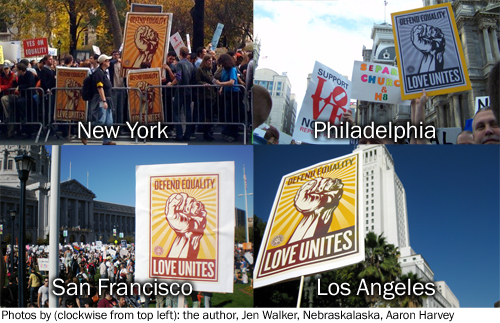
Re:Public
Branding Equality & Taking It to the Street:
An Interview with Aaron Harvey & His Work in the Anti-Prop 8 Movement
Since the crushing passage of LGBT rights activists and their allies have been protesting the vote that could invalidate some 18,000 marriages. If street artists have indeed played a seminal role in this year's election -- think Shepard Fairey & Obama -- they have yet to raise their voices in the anti-Prop 8 campaign... well, that was until this past weekend.
Released on Friday, November 13 via Towleroad, Obey Giant and the anti-Prop 8 campaign's Join the Impact website, a new Fairey poster called Defend Equality was already part of every major protest the following day at marriage equality rallies across the country.
Defend Equality is a striking graphic that is informed, like many of Fairey's works, by early Soviet design, American social realism and imagery associated with the labor movement. Dominated by a clenched fist, the poster shies away from the words "gay" or "marriage" in order to promote the fight against Prop 8 as a universal human rights issue.
What people may not realize is that Fairey's image was heavily inspired by designer Aaron Harvey. I caught up with Aaron online to discuss his image and the role street art plays in his work.
Why did Towleroad mention that you influenced Fairey's Defend Equality image? What exactly was your involvement?
F.A.I.R. and Join the Impact approached Shepard Fairey and asked him to do an original piece for the upcoming rallies. They were looking for something salient and universal. They had shown him a design that they really liked, my poster, and he said something to the effect of: "it's amazing as is, here's my take on it." So, it was an interesting collaboration of sorts, especially because he, along with people like Sam Flores and Urban Medium, influence me.
The Good Land
Eric Beltz
Morgan Lehman Gallery - 317 Tenth Avenue
9 October - 8 November
Eric Beltz's drawings first attract the viewer with the virtuosity of his crystal clear lines and elaborate surface patterns. When so much contemporary art smacks of an anyone-can-do-it aesthetic, this skilled draftsman wields graphite like a wand. But Beltz offers substance as well as a sophisticated technique. Viewers that dig deeper into his symbolism encounter a grisly vision of America's founding fathers. His gothic depictions may hit closer to the truth than what patriotism or good taste want us to believe.
Beltz is picky about his graphite and prefers sticks that are jet black without the onyx shimmer of cheaper, more reflective graphite. His arsenal of erasures corrects minor flaws and enables his technical perfectionism. The astute observer can still detect a ghost limb or phantom design haunting the picture plane, but they remain largely concealed.
The artist remarked to your commentator that "color for me is superfluous to my work right now." This chromatic absence draws attention to black lines as they expand, contract, intersect, compete, and run away from each other. It also assigns a pivotal role to how shading flavors perception and formal emphasis. Shapes collaborate with one another, appearing as individual leaves in one moment and then coalescing into the gestalt of a tree. These effects are not as explicit in color and can fly well under the radar in a painting -- here, though, they energize the work. Beltz's drawings reward taste for the subtleties that formally belong most clearly to drawing.
Severed heads floating above their bodies are a recurring motif. The agenda is to symbolize the disconnect between the principles and the actions of a young America's first white rulers. These men conceived bold ideals of social equality that were often riddled with caveats and inconsistencies. A profound contradiction remains between their efforts to forge a democracy rooted in equity and the privileged class that reaped the land's riches by enslaving Africans, decimating indigenous populations, and subordinating women. These works illustrate the disconnect between the mind's thoughts and the hand's commands. With skeletons, skulls, animal carcasses, weaponry and an arresting image of a slave, tarred and feather, Beltz vividly depicts a particularly American brand of death.
Text and phrases float beside most of the figures. These words often articulate the religious and ideological promises of utopia that inspired early European settlers on the American continent. Beltz's sharp juxtaposition of lofty words and bitter violence might first seem inflammatory, but this is in fact the very disjunction between reality and its ideological context that formed the young nation and paved the trail of tears.
After listening attentively to the voices of victims muted by previous histories, one becomes more and more curious about the mentality of their oppressors. Rather than indulging in tropes of monstrosity or evil, Beltz takes the risk to depict the numbingly violent landscape and the ambitious justifications of these darkly detached early Americans. With a muscular style and technique alloyed with a clever allegorical wit, Beltz's drawings dazzle and startle in sublime tandem.
Late last September, Working Artists and the Greater Economy, or W.A.G.E., a group composed of artists A.L. Steiner, K8 Hardy, and A.K. Burns, took the podium at the Park Avenue Armory during the Democracy in America, an exhibition and event program curated by Nato Thompson and organized by Creative Time. Like the rest of the country, they were speaking about money; but more specifically, about how artists weren't getting their fair share. While hearing artists complain about the market isn't surprising, W.A.G.E. isn't exactly comprised of marginal figures. These artists are frequently invited to exhibit their work in major institutions and likewise curated into important and highly visible exhibitions.
All of this success (or visibility) isn't what all that it seems. Artists like Steiner, Burns, and Hardy aren't getting large checks for the exhibition of existing art works. In fact, they may be getting nothing at all. For W.A.G.E., the grass is greener up north, in Canada, where artists have been entitled to royalties on exhibited works since the late 1980's -- something the artists in the United States have gone without. Founded in 1968 by a group of artists, the Canadian Artist's Representation (CARFAC) lobbied for nearly 20 years until its efforts resulted in an amendment to Canadian copyright law in 1988. The result, the Canadian Artists' Representation Copyright Collective, has since entitled artists to royalties whenever their art is exhibited. These royalties are doled out on a sliding scale depending on the scope and size of the exhibitor. An artist exhibiting at a small space could expect a few hundred dollars for the showing of a a single work, whereas a solo show of "international scope" could net them ten thousand dollars plus -- Canadian, of course.
There's been a noted lack of progress for anything similar in the United States. "The Artists' Contribution to American Heritage Act" -- a bill whose sole purpose was to rewrite a 40 year-old gaffe in the tax code -- appeared on the floor of the House in the spring of 2000, where it languished for nearly two years before disappearing completely. The bill, which changes the current policy of materials-only deductions for donations of art, would have allowed artists to obtain tax deductions equal to the work's market value upon donation to a museum, library, or non-profit institution -- a benefit which collectors already enjoy.
This wasn't always the case. Both artists and collectors were entitled to market-value deductions on donations before changes were made to the tax code in 1969, when artists (not collectors) were excluded in an effort to stem abuses of the code (allegedly, artists had been claiming inflated prices for their works). Even if this managed to save taxpayers a few dollars, it also gave serious incentive for artists to look elsewhere when donating major works. (Months after the code was amended, Igor Stravinsky reneged on a planned gift of his papers to the Library of Congress, instead opting to sell to a private collector in Switzerland).
The Impossible Life of Christian Boltanski
Christian Boltanski
6-8pm Tuesday 18 November 2008
Columbia University, Maison Fraçaise - 515 West 116th St, New York NY
Tomorrow evening at Columbia University's Maison Francais, artist Christian Boltanski will deliver the Eugene J. Sheffer Distinguished Lecture entitled The Impossible Life of Christian Boltanski. The lecture's title is a reference to an early word by the artist by the same title and dated from 1968, in which Boltanski presented a twelve minute film of the same title, in which "actors and crude dolls [interact] within a surreal setting. The film was originally shown in a small "room-like that could seat six or seven people amongst some of the dolls.

Triple Canopy Launch at Starr Space
8pm Friday 14 November 2008
Starr Space - 108-110 Starr Street, Brooklyn
$7 donation
Tonight at Starr Space in Brooklyn, Triple Canopy celebrates the release of their fourth issue, War Money Magic, which will be released in parts over the next few weeks on the journal's website. For the release, Canopy presents a sound and action performance by collective New Humans, comprised of Howie Chen and Mika Tajima. Also performing tonight is Brooklyn-based grunge metal duo Orpha, who just released Aborted by Birth on critic and curator Bob Nickas' promising new label, From the Nursery (the white vinyl edition of which is limited to 666 numbered copies). Bob Nickas will also DJ tonight, along with Sonic Youth's Mark Ikbold. On occasion of the release, Starr Space and Triple Canopy with also present a new exhibition on view tonight with work by Colby Bird, Jonah Groeneboer, Andres Laracuente, Matthew Lusk, Rachel Owens, John Powers, and Lucy Raven.
Evidence of a Lost Era
Cui Guotai
Chinasquare New York - 545 W. 25th St, 8th Fl, New York NY
1 October - 1 November 2008
Much ink has been spilled recently over the question of the economic crisis. There are some who want it to be a watershed, a sign that civilization can really break itself out of its contemporary dead end. We had heard over the past few decades that capitalist society had become post-industrial, a "postmodern condition" fueled by ever more abstract flows of global finance capital; today, it seems increasingly clear that what had looked like a qualitatively new form of socioeconomic existence is in fact bedeviled by the very same contradictions as the old. Appropriately, the crisis on Wall Street has not yielded any novel ideological solutions. On both sides of the ideological divide, sincerity has been replaced by desperation: the Right no longer believes in a pure market, only in the spoils of controlling the state apparatus, while the Left is scared to death of putting forward a new idea instead of dressing up the dessicated corpses of Social Democracy (which has proved unable to escape being implicated in the financial catastrophe) and Che Guevara quixotism. The crisis suggests the possibility that we might be forced into some truly new configuration, simply by the ineluctable logic of market events.
To believe this is to dream the great dream of the twentieth century — that the economic process could hold the key to a transformation of human existence. It was the stuff of science-fiction fantasies, to be sure, and served as the unconscious collective aspiration of bourgeois Great Societies. But it was equally the substance of the socialist vision. Collectivization, the first Five Year Plans, the Great Leap Forward: these were not simply economic policies but the outlines of a productivist utopianism that could overcome rather than resolve the class struggle. Productivism was fundamentally an aesthetic vision — look, for instance, at Marinetti in 1909:
We will sing of ... the gluttonous railway stations devouring smoking serpents; factories suspended from the clouds by the thread of their smoke; bridges with the leap of gymnasts flung across the diabolic cutlery of sunny rivers: adventurous steamers sniffing the horizon; great-breasted locomotives, puffing on the rails like enormous steel horses with long tubes for bridle, and the gliding flight of aeroplanes whose propeller sounds like the flapping of a flag and the applause of enthusiastic crowds.
Well this is delightful. Likely the work of high-gloss uber-pranksters, The Yes Men, the faux-Times handed out all across the city this morning was more than just a welcome break from Wednesday morning routine. Dated July 4, 2009, and depicting a sort of liberal utopia that has risen from the continued efforts of the Obama coalition, the spoof’s message couldn’t be clearer or more urgent: For God’s sake, Let’s not stop now.
In this respect the timing and execution of the piece are excellence manifest – it appears that no expense was spared, and the facsimile is altogether double-take worthy. What’s more, there is no definitive attribution anywhere to be found – the masthead is a historical lexicon of luminous, if reliably soft, leftists like Thorstein Veblen and Robert Owen – and the finest print is merely a directory of advocacy groups whose wish list is realized on the paper’s pages. The effect is quite striking, first the wtf factor, than the laughter, and then finally, the wincing, fang-sinking pangs of sadness that mark successful satire – what if, wouldn’t it be, if only... But wait! This is no ordinary Wednesday! We have not yet finished rinsing History's sparkles from our hair! Our eyes still bear the happy smears of so much made-up progress! We are still drunk on change! There is nothing we cannot accomplish. And here we the see the true genius of this surgical art-strike: it is not in the particularities of its proposals, it’s that the iron has never been hotter.
All involved are to be truly and honestly commended. This is viscerally intelligent, passionately committed, seamlessly perpetrated poetic terrorism of the highest order, it made my morning and made me think. This is established.
CHEW THE FAT
Rirkrit Tiravanija
8pm Friday 14 November 2008
Guggenheim Museum - 1071 5th Ave, New York NY
This Friday evening, the Guggneheim museum will screen Rirkrit Tiravanija's Chew the Fat, a new feature length documentary on the art of the "1990s art" that is so often deployed as a short-hard to talk about the Euro-American axis of artists involved with theanyspacewhatever exhibition. Structured as a series of interviews the artist conducted with his colleagues, the suite of videos arrives as a welcome stage for self-representation in an otherwise deeply contested critical field. The videos will also be shown on the cinema screen the evening of Tuesday, 2 December, as well as Sunday and Monday afternoons.
Continual Partial Awareness
A New Performance by Cory Arcangel
8:30pm Friday 14 November 2008
New Museum - 235 Bowery, New York NY
$8
There is a particular aesthetic quality to the half-interested everyday in contemporary life. Or so the artist Cory Arcangel seems to be suggesting with the press release for Continual Partial Awareness, a new performance being presented at the New Museum this Friday. The tendency towards a model of multitasking productivity wildly pervading software interface design has engendered a novel understanding of engagement: a task or an individual may occupy our time - and then, only with qualification - only until an interruption occurs, a mobile device vibrates, the computer announces a new message or an active application begins to visually beg our attention. The performance is part of Lauren Cornell's New Silent Series. From the press release:
According to the artist: “This performance is going to be about ‘Continuous Partial Awareness’—a phrase that was first described to me as meaning ‘you know, like, when you have three IM windows open, two e-mail in boxes dinging away, are texting five different people, and also have five tabs open on your browser, each with updated content.’ It is about paying attention to everything all the time, but not really concentrating on anything. It is different from multitasking, because with multitasking, one actually is expected to concentrate on tasks at some point, even if in small doses. ‘Continuous Partial Awareness’ is the eroded degenerate modern version of multitasking. I still don’t know how this performance will take shape, it might be a lecture, a music show, a broadcast, a chess game, etc., but what I do know is that the feeling of ‘non-concentration’ that has seeped into today’s life through our flat-screen displays and Wi-Fi will be its starting point."

Cultural Power: Tom Stoppard and Derek Walcott
7pm Monday 10 November 10, 2008
The Graduate Center - 365 Fifth Avenue, New York NY
Proshansky Auditorium
On Monday, 10 November, writers Tom Stoppard and Derek Walcott will lead a conversation on power and cultural production. Derek Walcott is a Nobel Prize-winning poet and playwright of Caribbean origin. He is widely regarded as one of more major literary figures of contemporary, post-colonial fiction. Recurring themes of confused or splintered identities and a pastiche style prevades much of his creative work. Tom Stoppard is a Czech-born, British-raised and internationally regarded screenwriter and playwrite. He is recently most most well known for his work on the screenplay for Brazil and Shakespeare in Love, but his output as a dramatist has been produced and well received since the mid-60s. Stoppard's work, much like Walcott's, often takes historical literary or mythic figures and narratives and parses them in distinctly 20th century fashions. Their conversation will be moderated by historian David Nasaw. It will take place as part of the Great Issues Forum, hosted by The Graduate Center at CUNY. The event is free but registration is required.
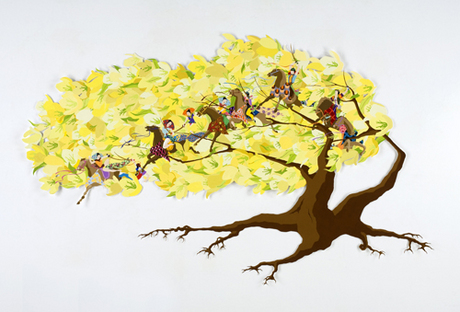
Except in Struggle
Casey Ruble
Foley Gallery - 547 W. 27th St, New York NY
14 October - 15 November 2008
Despite a shortening of Marinetti's "except in struggle there is no more beauty," for a title and its consistent battle theme, Casey Ruble's solo show now on view at the Foley gallery is an entirely pacific, even pleasing presentation. Working equally well as a traditional gallery-style showcase and as a gently confident conceptual narrative, Except in Struggle is an extremely strong debut.
Ruble works in oversize paper cutouts of painstaking detail and complexity; setting images of Japanese warriors locked in densely patterned, rhythmic combat against the classic wuxia battlefields of trees and waterfalls. In three oversize pieces, these cutouts are simply affixed to the wall, giving them a delightful, provisional quality that highlights the delicacy of their craftsmanship. What is so striking is Ruble's ability to combine an almost industrial iteration with the natural movement of her settings. Warriors move though trees like leaves, or tumble down a waterfall in waves, but do so with all the suggestive uniformity of an assembly line. Conflict is here written into the natural fabric, an almost disturbing, steadfast refusal of that typical solacing conceit which labels any and all human agonism somehow artificial, unnatural, as though napalm were made on Mars.
This sort of reverse alienation effect is further muted by several smaller formal studies that hang opposite the larger, more densely imbricate works. These are technically abstractions of Japanese crests that have been layered over one another, a sort of whimsically literal symbolic combat. Considered contextually however -- with the warriors in the larger pieces costumed frequently in patterns "derive(d) from sources including Islamic architecture, Art Nouveau designs, Chinese lattices, and 1960s op-art geometries…" to name only those cited in the press release -- the smaller, framed studies almost seem a highly stylized model or seed, an earlier, as yet unpacked instantiation of the larger pieces. These works, in turn, appear as exploded; the smaller sorties translated and expanded: an exquisite grafting of post-Fordist international eclecticism onto some determinately impoverished Western samurai fetish. It's Robert Wilson directing the Rockette's production of Crouching Tiger, Hidden Dragon, and it's fantastic.
Which is the other thing, at the risk of sounding gauche, Ruble's in the first work in years that I actually wanted to own. It's a strange sensation; a slow, unwinding feeling of being at home in front of a piece. Quite frankly, I almost never have it. Usually if a work is good it is precisely the opposite feeling, namely that it should be on public display or not at all. But with Except in Struggle I had that adolescent urge to hoard, and I was suddenly reminded of being, technically, in a store. I like to consider myself pretty well inoculated against the temptations of the commodity, so I offer this, I think, as further evidence of these works' distinct beauty. Beauty being, in aughtie-eight, that sort of decidedly self-interested, particular, inessential and yet purposive quality that has become the ephemeral engine of high-end commerce; the casual grip of well-tempered merchandise. It's a hateful feeling, appearing only when confronted with things we absolutely adore.
Shimon Okshteyn
Heist Gallery - Shimon Okshteyn at Heist, New York NY
10 October - 7 November 2008
For one more week, merry wanderers and afternoon flâneurs can find a funhouse gallery of mirrors hidden on a quiet block of Chinatown. Tucked between two small shops on Essex Street south of Delancey, you can enter a wormhole that will send you back to a Coney Island spectacle or a Times Square peep show. But peek around the corner of a mirror and you will see nary an amusement ride technician nor a beautiful girl, but a cheerful gallery attendant eager to hand you a press release.
Shimon Okshteyn's show, Reflection on Reality, is the fourth exhibition at the newly opened Heist Gallery located in eastern Chinatown. The immersive installation, including a mirrored floor, is made up of slightly distorted mirrors bolted to the gallery walls. The mirrors swell and contract light and splinter where the screws bite. Thin purple and pink neon bulbs light the hall, bouncing against the opposing mirrors, and illuminating the space with an appropriately artificial glow.
The focal piece of the exhibition is a voluminous protrusion of glass that juts out of the left gallery wall. Composed of broken glass sutured together to form a small peak, the horizontal mountain is surrounded by painted canvas, and decorated with a graphic lace-like pattern. The rupture is wonderfully frightening, a 3-D realization of the sinister curiosity that leads us to the hedonistic spaces of amusement parks and red light districts.
Okshteyn does undermine some of this darkness with what looks like a computer-generated decorative overlay. But what he takes away, he gives back in a small painting titled Julie, an image of a woman post-coital. On its own the work is charmingly rough, endearing in its earnest simplicity. Coupled with Boy Smoking, a slightly larger painting of a boy doing just that, and placed in this seedy and otherwise reflective context, the works charm while making sure gallery goers catch the sexual undertone.
The strength of Okshteyn's exhibition comes not from the material installation or individual works here on display, but rather from the totality of the exhibition as both environment and an unlikely observation deck for the surrounding neighborhood. The most interesting vantage point is at the far back of the narrow gallery space, looking out. Standing against the back wall, the glittery mirrors frame a captivating view of the life of the Lower East Side breathing and moving outside the gallery window.
Only a handful of blocks south of the glossy bars, nightclubs, and organic markets that now suffocate the once Caribbean and Italian arteries of the Lower East Side, Essex Street between Hester and Grand remains a relatively unblemished stretch of Chinatown. Across the street, past the slightly beat up Toyota and Ford sedans, is a modest basketball court presided over by the forlorn towers of Cooperative Village. Although Heist Gallery is one of the several cultural enterprises that dot the neighborhood map, for the length of Okshteyn's show they provide something unique: a remarkable opportunity to sit and appreciate the comforting banality of everyday life that still has a place in this small corner of lower Manhattan.
In The Invention of Public Weather, writer Bilal Khbeiz describes Los Angeles as a place beyond history, a place where history is only ever rehearsed and depicted. In the short text, the city is described as a deeply produced environment, a kind of amnesiac oasis for a people as afraid of the empty desert all around as of a quickly vanishing public sphere. While divisions between ethnic enclaves prescribe the discreet local conditions for everyday life, a grid of expansive private spaces is further expanded by a dense network of roads and its accompanying automobile culture. Would it be so hard to imagine the Internet as such a place? Identifiable in many of the world's countries is a small suite of popular online super brands that drive tremendous network traffic. Since the popularization of the Web 2.0 style of interface and information design, these proprietary online services peddle primarily in new modes of mediated user interaction while, in a sense, eclipsing content. Hence the super brands of today are sites that only structure access to media, often indifferent to the content those structures deliver. What constitutes public and private space on the Internet, of course, is a complex question. The Internet is neither Khbeiz's Los Angeles nor anybody else's. But why not consider the digital fiefs into which so much of our time, keystrokes, and emotions pour each day? All you'd have to do is close eyes and recall five websites you visit daily.
These conditions naturally aggregate to an atmosphere where it is really a rare delight then, to learn that e-flux -- the enterprise at the center of one of the most interesting and active non-institutional hubs for cultural production in contemporary art today -- has decided to launch an online journal, featuring Khbeiz's text cited above. The format seems simple enough, recalling a Web before the exhaustive professionalization of its design. A single thin column of serif text often spans well over 2,000 words per feature and is only occasionally interrupted with images. Here is the model contrary to so much commercial design practice that has since turned the Internet into an imagined media oasis. It is precisely here that content is form, rather than the reverse.
E-flux's Journal is edited by Brian Kuan Wood, Julieta Aranda and Anton Vidokle. Its inaugural issue is now accessible freely online and includes contributions by Boris Groys (whose book Art Power, published earlier this year by MIT, has been gaining tremendous popularity with American readers), Omer Fast, Sebastjan Leban, Marjetica Potrč, Irit Rogoff, Pelin Tan, and the Raqs Media Collective.
If you live in New York, love street art and support Barack Obama, this year's U.S. Presidential campaign was bliss. The fact that street artists tend to lean Democratic doesn't really surprise anyone, but the Obama campaign's endorsement of street art probably does. This isn't the first time a politician has been the muse or patron of the art of the streets; Shepard Fairey did a Ralph Nader poster in 2000 and Howard Dean tried to incorporate graffiti in his 2004 Presidential run, but this may be the first time a Presidential contender has incorporated the urban art form as an integral asset to his or her campaign.
I've gathered some of the best images from this Presidential season which is featured in a slideshow below.
Next week expect an essay about how Election 2008 has impacted and may have changed street art forever.
Special thanks to Jake Dobkin, Billi Kid, Thundercut and others for special permission to use their images for this photo essay.
ZINE
HOME
TIPS / COMMENTS
CATEGORIES
CONTRIBUTORS
- Greg Afinogenov
- B. Blagojevic
- Adda Birnir
- Susannah Edelbaum
- Julie Fishkin
- Paddy Johnson
- Jessica Loudis
- Christopher Reiger
- Andrew Robinson
- Peter J. Russo
- Blythe Sheldon
- S.C.Squibb
- Hrag Vartanian


